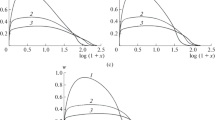Abstract
Exact and approximate relations have been obtained to describe the evolution of the following parameters of heated air parcels during their convective uplifting in the atmosphere: the altitude and temporal dependences of the speed of the parcel center, the parcel characteristic size (radius), and the excess relative temperature. Cases of moderate and strong heating have been considered. The original equations include relations for the rate of uplifting thermals, the mass of entrained cool air, and the complete integral of thermal buoyancy. It has been shown that during uplifting the radius of the heated air parcel increases, the excess temperature decreases, and the uplift rate varies nonmonotonically: first, it increases from zero and reaches a maximum; then it gradually decreases to zero. Numerical estimates for characteristic situations have been performed.
Similar content being viewed by others
REFERENCES
Yu. A. Gostintsev, E. A. Ivanov, S. N. Kulichkov, et al., “On the mechanism of infrasound wave generation in the atmosphere by large fires,” Dokl. Akad. Nauk 283 (3), 573–576 (1985).
L. F. Chernogor, “Physical processes in the near-Earth environment accompanying the military operations in Iraq (March–April 2003),” Kosm. Nauka Tekhnol. 9 (2–3), 13–33.
L. F. Chernogor, “Geophysical effects and geoecological consequences of mass chemical explosions at military depots of Artemovsk,” Geofiz. Zh. 26 (4), 31–44 (2004).
L. F. Chernogor, " Geophysical effects and geoecological consequences of the fire and explosions at the Melitopol’ military base," Geofiz. Zh. 26 (6), 61–73 (2004).
L. F. Chernogor, “Ecological consequences of mass chemical explosions during a technogenic catastrophe,” Geoekol. Inzh. Geol. Gidrogeol. Geokriol. 6, 522–535 (2006).
L. F. Chernogor, “The Earth–atmosphere–ionosphere–magnetosphere as an open dynamical nonlinear physical system. 1, Nelineinyi Mir 4 (12), 655–697 (2006).
L. F. Chernogor, “The Earth–atmosphere–ionosphere–magnetosphere as an open dynamical nonlinear physical system. 2, Nelineinyi Mir 5 (4), 198–231 (2007).
S. A. Pulinets, D. P. Ouzounov, A. V. Karelin, and D. V. Davidenko, “Physical bases of the generation of short-term earthquake precursors: A complex model of ionization-induced geophysical processes in the lithosphere–atmosphere–ionosphere–magnetosphere system,” Geomagn. Aeron. (Engl. Transl.) 55 (4), 521–5538 (2015).
The 1980 Eruptions of Mount St. Helens (Washington, D.C., 1981).
L. F. Chernogor, “Atmospheric effects of the gas-dust plume of the Chelyabinsk meteoroid of 2013,” Izv., Atmos. Ocean. Phys. 53 (3), 259–268 (2017).
S. Glasstone and P. J. Dolan, Effects of Nuclear Weapons (United States Department of Defense and Energy Research and Development Administration, Washington, D.C., 1977).
Yu. A. Gostintsev and Yu. V. Shatskikh, “On the mechanism of generation of longwave acoustic disturbances in the atmosphere by the emerging cloud of explosion products,” Fiz. Goreniya Vzryva, No. 2, 91–97 (1987).
B. R. Morton, G. Taylor, and J. S. Turner, “Turbulent gravitational convection from maintained and instantaneous sources,” Proc. R. Soc. London, Ser. A 234 (1196), 1–23 (1956).
E. Gossard and W. Hooke, Waves in the Atmosphere (Elsevier, Amsterdam, 1975; Mir, Moscow, 1978).
L. F. Chernogor, Physics and Ecology of Catastrophes (KhNU im. V. N. Karazina, Khar’kov, 2012) [in Russian].
Catastrophic Events Caused by Cosmic Objects, Ed. by V. V. Adushkin and I. V. Nemchinov (Akademkniga, Moscow, 2005) [in Russian].
N. N. Gorkavyi, T. A. Taidakova, and E. A. Provornikova, “Aerosol plume after the Chelyabinsk bolide,” Sol. Syst. Res. 47 (4), 275–279 (2013).
Author information
Authors and Affiliations
Corresponding author
Additional information
Translated by V. Arutyunyan
Rights and permissions
About this article
Cite this article
Chernogor, L.F. Dynamics of the Convective Rise of Thermals in the Atmosphere. Izv. Atmos. Ocean. Phys. 54, 528–535 (2018). https://doi.org/10.1134/S000143381806004X
Received:
Accepted:
Published:
Issue Date:
DOI: https://doi.org/10.1134/S000143381806004X



